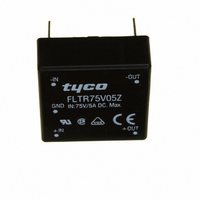FLTR75V05Z Lineage Power, FLTR75V05Z Datasheet - Page 5

FLTR75V05Z
Manufacturer Part Number
FLTR75V05Z
Description
FILTER MOD 75V 5A PC MOUNT
Manufacturer
Lineage Power
Series
FLTRr
Datasheet
1.FLTR75V05Z.pdf
(13 pages)
Specifications of FLTR75V05Z
Filter Type
Power Line
Current
5A
Mounting Type
Through Hole
Termination Style
PCB Pins
Voltage Rating
75 VoltsDC
Current Rating
5 Amps
Mounting Style
Through Hole
Filtered
Yes
Frequency
500 kHz
Product
Power Entry Filter Modules
Lead Free Status / RoHS Status
Lead free / RoHS Compliant
Inductance
-
Lead Free Status / Rohs Status
Lead free / RoHS Compliant
Other names
555-1103
CC109102654
CC109102654
October 2
Application
Conducted noise on the input power lines can occur as
either differential-mode or common-mode noise cur-
rents. Differential-mode noise is measured between the
two input lines, and is found mostly at the low-
frequency end of the spectrum. This noise shows up as
noise at the fundamental switching frequency and its
harmonics. Common-mode noise is measured
between the input lines and ground and is mostly
broadband noise above 10 MHz. The high-frequency
nature of common-mode noise is mostly due to the
high-speed switching transitions of power train compo-
nents. Either or both types of noise may be covered in
a specification, as well as a combination of the two. An
approved measurement technique is often described,
as well.
Differential-mode noise is best attenuated using a filter
composed of line-to-line capacitors (X caps) and series
inductance, provided by either a discrete inductor or
the leakage inductance of a common-mode choke. In
addition to the differential filtering provided by the filter
module, it is recommended that an electrolytic capaci-
tor be located at the converter side of the filter to pro-
vide additional attenuation of low-frequency differential
noise and to provide a low source impedance for the
converter, preventing input filter oscillations and load-
transient induced input voltage dips.
Common-mode noise is best attenuated by capacitors
from power module input to power module output,
capacitors from each input line to a shield plane
(Y caps), and common-mode chokes. It is recom-
mended that ceramic capacitors be added around each
power module from each input and output pin to a
shield plane under the module. The shield plane should
be connected to the CASE pin.
Lineage Power
The GND pin of the filter module is attached to Y caps
within the module. This pin should be tied to a quiet
chassis ground point away from the power modules.
GND of the filter module should not be tied to the
CASE pin of the power module since this is a noisy
node and will inject noise into the filter, increasing the
input common-mode noise.
If no quiet grounding point is available, it is best to
leave the filter module GND pin unattached. Each
power system design will be different, and some exper-
imentation may be necessary to arrive at the best con-
figuration.
Figure 5 shows a typical schematic of a power module
with filter module and recommended external compo-
nents. Figure 6 is a proposed layout. More than one
power module may be attached to a single filter module
as long as input current does not exceed 5 A. Figure 7
shows the recommended schematic for two power
modules attached to a single filter.
In applications where the addition of input to output
capacitors is undesirable, do not use C3 and C4 shown
in Figures 5 and 6, and do not use C3, C4, C8, and C9
shown in Figure 7.
In –48 V applications where the shield plane and the
power module case must be tied to a signal, remove
C1 in Figures 5 and 6, remove C1 and C6 in Figure 7,
and connect the shield plane and CASE pin to the V
plane.
In +48 V applications where the shield plane and the
power module case must be tied to a signal, remove
C2 in Figures 5 and 6, remove C2 and C7 in Figure 7,
and connect the shield plane and CASE pin to the V
plane.
75 Vdc Input Maximum, 5 A Maximum
5
I
I
(+)
(–)

















